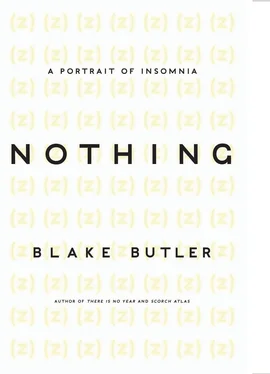In 1938, we get LSD. We get the ballpoint pen. Scholars perform experiments in isolation underground and in huge caves outside of light and speech and sound to show that there are periods innate to the person — that time is in our blood. Among children, it is cool, frontier-like, to stay up later. “Certainly one would never want to teach a child to be dependent on being held or rocked to sleep,” they say.121 Antonin Artaud coins the term la réalité virtuelle , which in coming years will be used to sell video games. At least 15 million bodies become murdered based on words emerged from one man’s mouth.
In 1945, we get the microwave oven, the Slinky, nuclear weapons. In 1946, we get mobile phones. Certain people are easier to find without their cooperation. Their bodies radiate the heat. We become targets, followed, complexly haunted. Carcinogens collect in pockets, at our cells. People start finding and naming even more sleep disorders, which beget more clinical diagnoses, which beget more and more and more medications. There are more books, more words within them, more ideas relegated to what a dream might mean. In 1950-something, Samuel Beckett writes: “Name, no, nothing is namable, tell, no, nothing can be told, what then, I don’t know, I shouldn’t have begun.”122
In 1951, Eugene Aserinsky records his eight-year-old son’s eyes through a whole night by EEG and EOG. He notices two phases of the eyes’ movement: twenty-minute periods when the eyes rapidly jerk around behind the lid, as if in seeing, and sixty- to ninety-minute stationary periods occurring regularly between. Based on this information, the basic model for sleep is renovated to include two major modes: when the eyes are still (non-rapid eye movement, NREM) and when our eyes move as they might in seeing while awake (rapid eye movement, REM). A single night’s sleep typically involves four to six periods of strobing between these two. Each lasts, on average, seventy minutes to two hours, with variation.
Later, the NREM period is further subdivided into four stages: Stage 1, in which the shift between waking and sleeping begins — becoming drowsy, the brain’s alpha waves turn slow; stage 2, in which the alpha rhythms slow down further, into theta, punctuated by small bursts of electricity called “sleep spindles.” These first two stages are often brief, but may stretch longer for the busy-brained, and may seem to some not like sleep at all. Stages 3 and 4 are known as delta sleep, the brain slowing down to high-amplitude, low-activity delta waves; muscle tone turns lax; the heartbeat quiets, decreasing metabolism; these stages serve as a door into REM. REM is further found to differ from the NREM in that the brain becomes dramatically activated in electricity and metabolic rate — blood flow to the brain increases 62 to 173 percent; flesh holds a cold-blooded mode; vast jumps occur up and down in breathing and pulse; we experience vivid dreams. Through these facets, sleep now at last has some ground of operational understanding that will hold on as scientific fact, though for the most part we’ll proceed almost nowhere in the way of knowing why any of it happens, or what it means.
In 1949, Egas Moniz wins the Nobel Prize for popularizing the lobotomy. We further customize our homes. Ranch-style homes become popular for their open floor plans and larger windows, allowing in more light. The first U.S. local TV station opens in Pittsburgh.
In 1952, David Tudor performs the premiere of John Cage’s 4’33” . “There’s no such thing as silence,” Cage says. Sales of teddy bears increase. Bedtime stories are commonly cliff-hangers. People binge eat inside their sleep, not remembering why their refrigerators in the morning look so empty, why they want. Playboy unveils a kind of flesh upon the stands. Six years later, the Barbie doll follows with its own malformed body image, its representational sex organs removed.
In 1960, we get the laser. We get hypertext and the wristwatch. There are more and more machines each day counting the time, with mixed results. Watches not watched will die and stay stuck on one specific time. In the night, in rooms, the working rotating second hands can be heard to click. Small distractions often loom longest in the face of what seems nowhere, and yet is everywhere at once. We feel we need more information.
“What madness gained in precision through its scientific outline,” writes Michel Foucault, “it lost in the vigour of concrete perception; the asylum, where it was to rejoin its truth, was not a place from which it could be distinguished from that which was not its truth. The more objective it became, the less certain it was. The gesture that set it free in order to investigate it was also the operation that disseminated it, and hid it in all the concrete forms of reason.”123
In 1961, the Association for the Psychophysiological Study of Sleep (APSS) is founded, initializing the first official institution of organized sleep medicine. A series of national sleep disorder centers opens across the country, all of them together brought together in 1976 by the Association of Sleep Disorder Centers (ASDC), one year after Ed Roberts coins the first personal computer. Soon, from that first node of centers, there are born even more sleep associations, such as the Sleep Research Society (SRS) and the Clinical Sleep Society (CSS), so many that in 1986 they all band together to form the Association of Professional Sleep Societies (APSS), which changes its name to the American Sleep Disorders Association (ASDA) in 1987 and again to the American Academy of Sleep Medicine (AASM) in 1999. Quickly the federations of associations spread across the globe, each with its own abbreviation: the ESRS, the JSSR, the BASS, the SSRS, the LASS, the SSC, the BSS — all these organs in one massive body.
In 1962, Walmart is founded and opens for business — nearly fifty years later, one-third of America will shop in one of the chain’s 4,000-plus locations every week — among a strong unwinking white light, consumed with sound.
In 1965, we get the digital clock. Depression spreads, begetting ritualizing of regular visits to the shrink. A farmer in Kiev uncovers the oldest known constructed dwelling, dating to 10,000 BC, comprised of mammoth bones.124 We understand there could be older houses underneath our other houses, or maybe graves. More light sinks into our lymph. In 1966, locked-in syndrome is discovered, a condition in which a person is conscious and awake but cannot move his or her body beyond the eyes. The Air Force begins to train their men in target practice using simulation-based machines: programs in which the images of electronic men are murdered and, when reset, will live again. The Super Bowl begins. In 1968, regarding his near-death experience being shot by Valerie Solanas, Andy Warhol says, “It was just as if I was watching another movie.”125 The gold standard for U.S. currency is repealed.
“You must never sleep,” writes Anton LaVey in 1969, “never daydream, never be without a vital thought, and never have an open mind.” We define jet lag, conditioned insomnia, problem snorers, noise pollution. Charles Manson is on TV. The Death of God is now a popular theological movement, appearing on the face of Time . Years, for many, as they pass, feel less like years, shorter in spanning and longer in the minutes of the day. Parts of songs begin appearing inserted backwards in popular music, advertisements, infecting our idea of what we hear in what we hear.
In the 1970s, we get digital photography, videocassettes, pocket calculators, instant noodles, space stations, e-mail, and karaoke. For the first time, narcolepsy is diagnosed in a dog. Reverend Jim Jones installs speaker systems in his Peoples Temple commune in Guyana, broadcasting his ranting at all hours, through the night. “A lot of people are tired around here,” Jones says, “but I’m not sure they’re ready to lie down, stretch out, and fall asleep.” Kales associates insomnia with a state of “constant emotional arousal,” whose physiological effects include high heart rate, restricted veins, raised rectal temperatures, and an increase in body movement while trying to nod off — all, for him, by-products of internalizing one’s emotions and environments, absorbing them into the blood. We get microprocessors, Ethernet, the personal computer, the Happy Meal. We get stereo, the Walkman, the Rubik’s cube, DNA sequencing, the digital camera, Gore-Tex, Atari. Gary Gilmore, facing his own death, demands, “Let’s do it.” The world population passes four billion.
Читать дальше












